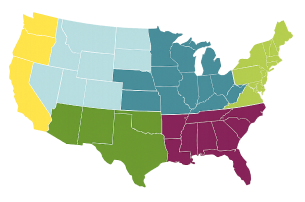All About Echinacea
Posted By American Meadows Content Team on Mar 24, 2017 · Revised on Oct 3, 2025

Knowing your location helps us recommend plants that will thrive in your climate, based on your Growing Zone.
Posted By American Meadows Content Team on Mar 24, 2017 · Revised on Oct 3, 2025

Echinacea means cold relief to some people. Capsules made from the plant are a staple at stores stocking herbal remedies. Environmentalists and activists think of Echinacea in the context of habitat restoration and use it to provide food for pollinators. Newbies embrace Echinacea because they’re so easy to grow, while plant fanatics have spent the last decade snatching up new hybrids and going coneflower crazy for plants such as ‘Evening Glow’ (bi-color pink and yellow petals) and ‘Pink Double Delight’ (bright pink petals & soft, cushiony center).
Really, regardless of your gardening style or level of experience, it’s hard not to be excited about Echinacea! They’re drought-tolerant, birds and butterflies love them, they don’t scramble through the garden eating up every inch of available space, they will grow in terrible soil, and they require little maintenance. I’m certainly in love.
Echinacea plants are native to the eastern half of the United States, and they grow natively from Texas up to North Dakota and eastward to the Atlantic Ocean. However, they’ll flourish in just about any garden, continent-wide, given the right conditions.

For something to earn a spot in the garden it had to offer a few qualities: showy, colorful flowers, easy to grow, and a favorite of butterflies. She wanted her garden to be a source of cut flowers and butterfly nectar. It tickled her to no end, sending me pictures of herself standing next to some giant plant, a butterfly perched on the blooms next to her shoulders.
Because they are plants from my childhood, growing Echinacea gives me a link to my mom (who also grew coneflowers) and my grandma, ensuring there’s always a piece of them at home with me.
Echinacea is a genus of 11 species of herbaceous perennials native to North America. The botanical name comes from the Greek word echinos, which means “spiny” like a hedgehog. That, and the plant’s common name, refer to the spiky cone of seeds that form the center of the flowerheads. Echinacea purpurea, the purple coneflower (even though it has pinkish petals) is one of the most commonly-grown species. There are now dozens of hybrids available in a huge variety of heights with a wide range of flower colors, from bright pink to white to two-toned yellow, orange, and more. Some have flowers that maintain the traditionally recognizable daisy shape and a large center cone, while others look like pom poms. Some have flat-topped flowers. Whatever your garden’s color scheme, there is likely an Echinacea that will fit.
The reason the botanical name, Echinacea, is so familiar to most people is, yes, the cold & flu aisle at the drug store. Roots of Echinacea purpurea and Echinacea angustifolia were traditionally used by Native Americans to heal a wide range of ailments. Today, you find extracts in cough drops, and capsules of ground up plant parts touting immune boosting benefits. Whether it works for you is up to you. Be careful if you partake, as some people are allergic to Echinacea.
If you wanted to invite birds, butterflies, dragonflies, bees, and other pollinators to your garden and the only plant you planted was Echinacea, you’d still be miles ahead of other gardeners. In the 1990s everyone became really excited about butterflies, and why not, right? They’re gorgeous. As a whole, gardeners have clued into the fact that in addition to supporting butterflies, we can do a lot of good for our environment and our food supply by supporting all pollinators.


To feature Echinacea in your pollinator garden, choose a site in full sun with well-drained, easy to work soil. (Echinacea can handle partial sun, but many other pollinator favorites will not.) The National Pollinator Garden Network suggests planting “targets” of pollinator plants, which means large groups. Pick out a few plants that play well with Echinaceas (Russian Sage, Yarrow, Phlox, Rudbeckia, Goldenrod, Sedum, and Bee Balm) and plant blocks of them together in the landscape or flower bed. This will create a dramatic effect, and you’ll have something blooming almost all summer long - another key recommendation for pollinator gardens.
Add a water source, such as a bird bath, and limit pesticide use (You shouldn’t need them—these plants have few pest problems), and you’re good to go.
I absolutely love growing wildflowers, and Echinacea is one, from seed. Many wildflower seeds, particularly those of perennial flowers, require a cold, damp treatment of their seeds in order for the seeds to germinate. If I were to guess, I’d say this is an evolutionary trait that keeps the seeds from sprouting as soon as they drop from the plant and allows for better dispersal and survival. (If a seed sprouts during a warm week in October the plant might not survive the winter.)
Sow Echinacea seeds outdoors in the fall so they can undergo a natural scarification process (freezing, thawing and cracking of the hard outer case) during the winter. Lightly cover. I always sow thickly to leave a little for the birds; they will inevitably find the seeds and eat some. Growing Echinacea this way is simple and fun. I think it’s like a treasure hunt in the spring to see what sprouted.
About the Author: Katie is a writer, runner, and reader, living in southern coastal North Carolina. Her favorite garden is her "wild flower patch" where something new is always blooming (or taking over).
To learn more about the plants & seeds we sell and how to grow them in your garden beds and patio containers, sign up for our inspiring emails.